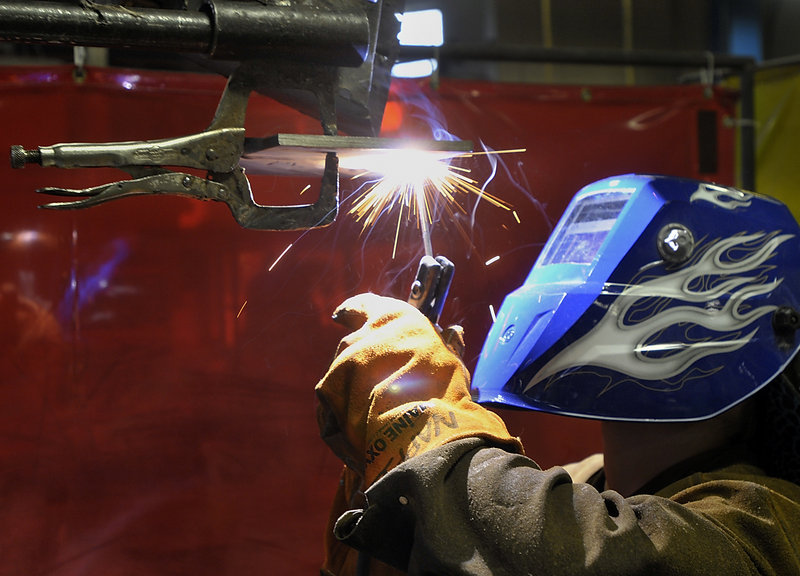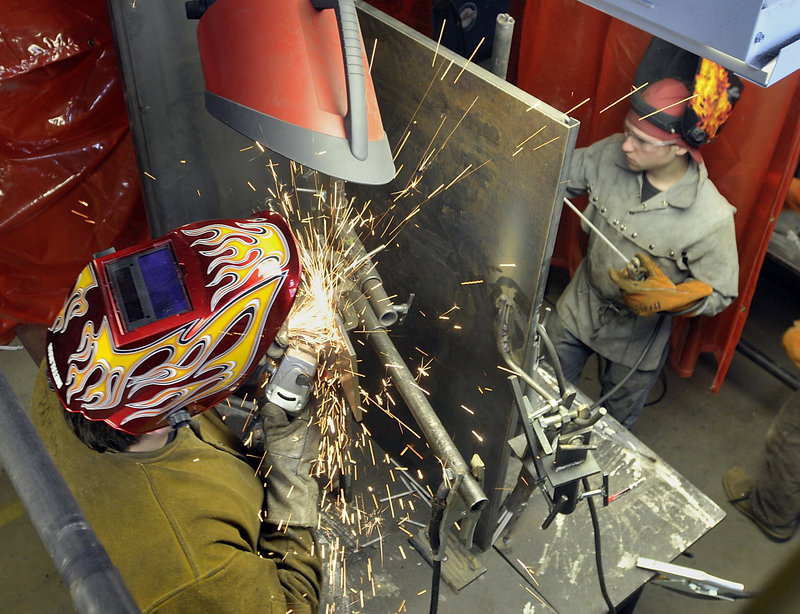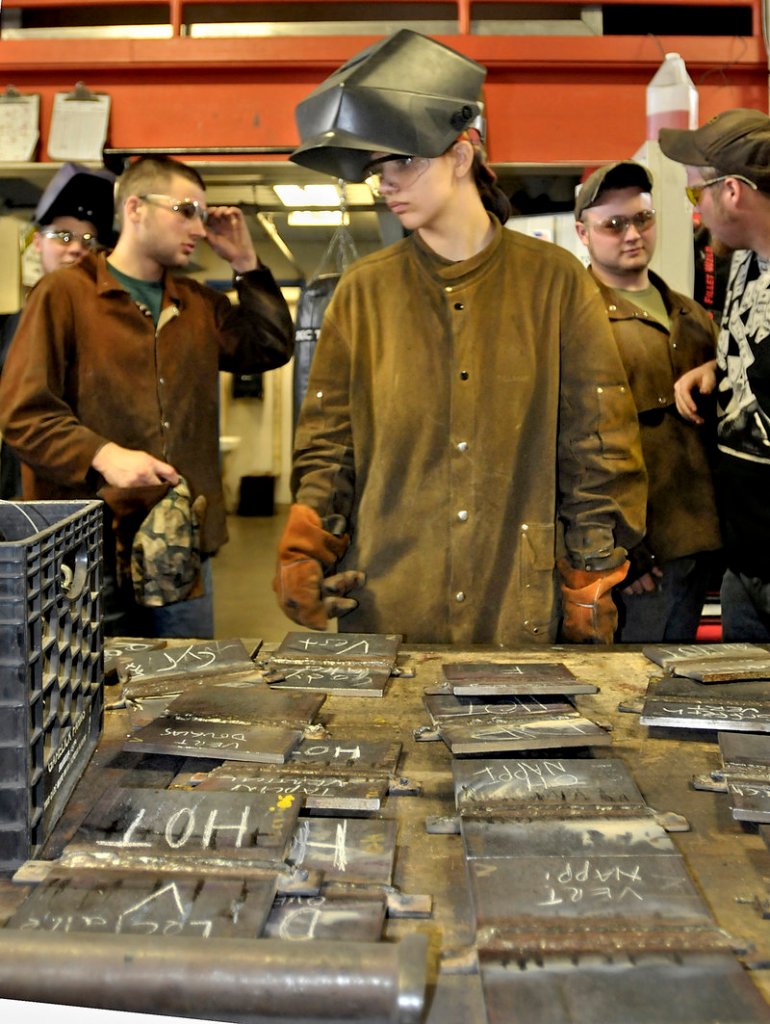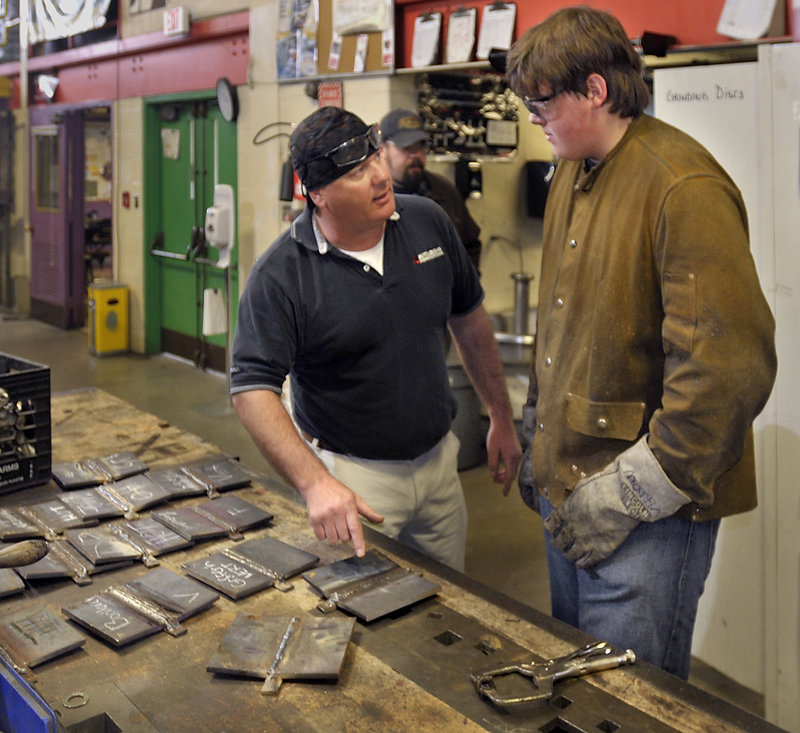PORTLAND — Justin Halladay emerged from a shower of sparks holding two welded steel plates about the size of a paperback novel.
Bill Presby, Halladay’s welding instructor at Portland Arts and Technology High School, checked the inch-wide steel bead joining the plates and nodded his approval.
“I was a little nervous at first,” Halladay confessed, “but I got over it.”
Halladay, who lives in Scarborough, was among 25 students at the regional vocational school who took a national certification test Wednesday to demonstrate their proficiency in shielded metal arc welding.
The test was monitored by instructors from Eastern Maine Community College in Bangor, which offers the only associate-degree welding program in the state.
The testing session was a first for high school students in Maine and a rarity in the United States, according to the American Welding Society.
Students who pass the test – Presby expects most of them will – will graduate from high school prepared for steady, well-paid jobs and help fill a rapidly growing need for qualified welders across the country.
Welders can earn annual salaries from $30,000 for entry-level work to $100,000 for specialties such as underwater welding.
Wednesday’s testing session also reflects changes coming to 27 vocational high school programs across the state, said John Marcigliano, student services coordinator at PATHS.
Starting next year, the Maine Department of Education will require all vocational high school students to demonstrate proficiency in courses ranging from carpentry to culinary arts by taking similar certification tests based on national professional standards.
The American Welding Society’s standards are exacting. Stick-welding samples produced by the PATHS students will be sliced into strips, bent into 180-degree curves and examined for any cracks or openings, said Tom Giles, director of the welding test center at Eastern Maine Community College.
The test takes into account each student’s dexterity and knowledge in working with flaming-hot tools and metals, understanding related math and science concepts and following workplace safety regulations.
“This isn’t a fluff test,” Giles said. “Guys who have been in the industry for 20 years take this test. Certification sets these kids apart from the person who says, ‘I can weld.’“
Certification also puts the PATHS students on the fast track for jobs or further training in a high-demand field.
The average age of the 276,000 certified welders in the United States is 54, said Cindy Weihl, the American Welding Society’s spokeswoman.
By 2012, the nation will need at least 200,000 welders to build everything from ships and bridges to skyscrapers to power plants. Companies have started hiring welders from India and the Philippines.
The dearth of U.S. welders developed over the last 20 years, Weihl said, as educators and others promoted college and white-collar careers over vocational training and skilled trades.
That trend has shifted recently, largely because the recession put many bankers and business people out of work.
Welding schools across the country are reporting record enrollments and waiting lists, Weihl said, and the number of certified welders increased 4 percent in the last year.
The program at PATHS has been filled in each of the last six years, Presby said, and he’s bumping enrollment from 31 to 40 students in 2010-11 because of growing demand. PATHS serves students from 23 high schools in the Portland area.
Presby’s welding program was ideal to incorporate national certification, said Chris Maseychik, chairman of welding technology at EMCC.
“John runs one of the best welding programs in Maine,” Maseychik said. “It’s the biggest high school welding program in the state and businesses are eager to hire his students.”
Presby learned welding through the adult education program at PATHS, then worked in the industry for 17 years.
He started teaching at PATHS as a volunteer 17 years ago, when he was out of work because of an arm injury. He discovered that he enjoyed teaching, and eventually took over the program.
Presby credits several businesses — Phoenix Welding, ATA Piping, Casco Bay Steel, Cianbro, Maine Oxy and Jotel North America — with donating time and materials to PATHS’ program and for regularly hiring his students.
“Without those companies, we wouldn’t be here,” Presby said.
Rose Pyle-Carter is one of two girls who took the $150 certification test on Wednesday.
She’s a home-schooled 16-year-old who lives in Westbrook and also takes college courses.
Pyle-Carter said she’s willing to wear leather welding gear and handle hot steel because she will soon be able to make $20 an hour — more than twice the pay she gets for a part-time clerical internship.
“I would like to work at Bath Iron Works,” she said.
“I’m hoping to apply for their apprenticeship program. In a few years, I could be building ships.”
Justin Halladay has the same kind of clear-eyed vision.
The Scarborough High School senior plans to work for a welding company for a year after graduation and save some money.
Then, he plans to enlist in the Coast Guard and work on its boats.
“That’s what my dad did for 23 years,” Halladay said.
“I definitely feel more advanced than some of the kids I go to high school with. Some of them have no idea what they’re going to do when they graduate.”
Send questions/comments to the editors.






Success. Please wait for the page to reload. If the page does not reload within 5 seconds, please refresh the page.
Enter your email and password to access comments.
Hi, to comment on stories you must . This profile is in addition to your subscription and website login.
Already have a commenting profile? .
Invalid username/password.
Please check your email to confirm and complete your registration.
Only subscribers are eligible to post comments. Please subscribe or login first for digital access. Here’s why.
Use the form below to reset your password. When you've submitted your account email, we will send an email with a reset code.